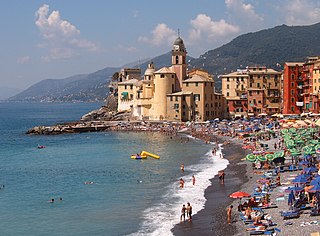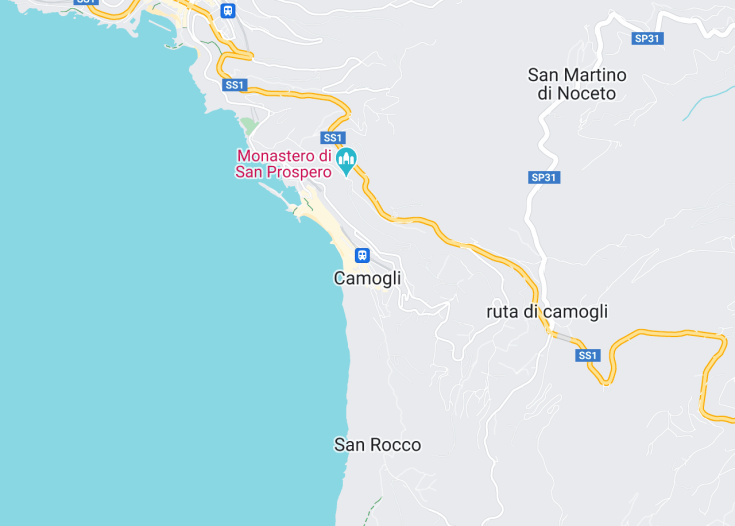Nestled on the rocky Italian Riviera coastline, Camogli is a picturesque seaside village renowned for its maritime heritage and vibrant architecture. This hidden gem captivates travelers with its small pebbled beaches, pastel-colored houses stacked along the waterfront, and an ancient marina buzzing with local life. The heart of Camogli beats around its historic Basilica of Santa Maria Assunta, showcasing splendid Baroque architecture that offers a step back in time. This charming locale is perfect for those who seek serenity away from the bustling tourist spots, providing a taste of Italy’s authentic coastal lifestyle.
Be sure to explore the fishing boat harbor, where you can observe local fishermen and perhaps catch the lively fish market in action, offering a true sense of Camogli’s culture.
Visit during the spring or early summer to enjoy milder weather and smaller crowds, ideal for soaking in the panoramic seaside views and exploring the village’s winding streets.
Top things to do & see in Camogli
Select the following sights and activities to discover best tickets and tours available in Camogli.
Camogli: A Glimpse into Riviera Paradise
| Country | Italy |
| Time in Camogli | GMT+1 |
| Language spoken | Italian |
| Population | 5,500 (Source: ISTAT, 2021) |
| Currency | Euro (€, EUR) |
| Airports |
|
Camogli, nestled on the Italian Riviera in the Liguria region, stands as a quintessential fishing village with a captivating history that dates back centuries. Historically, this picturesque enclave has been a sanctuary for maritime activities, characterized by its quaint harbor and vibrantly colored buildings that cascade down to the waterfront, fascinating all who visit with their enchanting aesthetic. Today, it is celebrated not only for its historical significance but also for its role in promoting cultural tourism, hosting numerous festivals and events that showcase its rich heritage and vibrant local culture.
Where is Camogli?
Camogli is situated on the west side of the Portofino peninsula in northern Italy, offering stunning views of the Ligurian Sea.
Distances:
| Route | Distance by Car | Time by Car |
|---|---|---|
| Milan to Camogli | 93 miles / 150 km | ~2 hours |
| Florence to Camogli | 134 miles / 215 km | ~2.5 hours |
| Rome to Camogli | 293 miles / 472 km | ~5 hours |
What is Camogli famous for?
Camogli is renowned for its vibrant maritime heritage, reflected in the annual Fish Fry Festival and the historical Basilica of Santa Maria Assunta, featuring breathtaking views and intricate designs that capture the spirit of the region.
History
Pre-Roman and Roman Origins
The history of Camogli, located on the Italian Riviera in the province of Genoa, Liguria, begins well before it became known by its current name. The area was originally inhabited by Ligurian tribes before falling under Roman influence. By the fall of the Roman Empire, small fishing communities had begun to form, laying the foundational culture for the future town of Camogli.
Medieval Era (1000-1500)
During the medieval period, Camogli was a mere fraction of its future self, consisting mainly of humble fisherman’s huts. The name “Camogli,” which translates to “house of wives” (Casa delle Mogli), was reputedly coined because the fishermen were often at sea, leaving the village populated primarily by their wives. In this period, the village was under the feudal lordship of the Abbey of San Fruttuoso.
Rise of a Maritime Power (1500-1800)
The expansion of maritime trade in the 16th century saw Camogli blossom into a significant naval power. By the 17th century, the town was known for its formidable fleet, reputedly consisting of hundreds of ships. This period marked significant economic and social growth, resulting in the construction of many of the town’s emblematic buildings, including churches and luxurious captain’s homes, reflecting its maritime prosperity.
Decline and Rebirth (19th century to World War II)
The 19th century saw the decline of Camogli’s maritime dominance due to advancements in shipping technology and changes in global trade routes which it could not compete with. However, towards the end of the 19th century, the town found a new lease of life as a picturesque tourist destination, thanks in part to the burgeoning industry of tourism.
Contemporary Camogli (Post World War II – Present)
The post-World War II period through to the present day has seen Camogli reinforce its reputation as a popular tourist destination. Its historical and environmental assets are preserved through proactive local policies. Today, Camogli combines its rich historical tapestry with the vibrancy of modern hospitality, offering an immersive experience to all who visit.
Visit Camogli
What to see and do in Camogli
If you’re planning a visit to Camogli, there’s a plethora to see and do in this charming Italian town:
- Explore the picturesque harbor with its colorful buildings and traditional fishing boats.
- Visit the Basilica of Santa Maria Assunta for its architectural beauty and historical significance.
- Take a leisurely walk along the scenic promenade ending at the Camogli beach.
- Discover the Dragonara Castle, situated on a rocky outcrop overlooking the sea.
- Enjoy local Ligurian cuisine at one of the many waterfront restaurants.
Festivals in Camogli
Camogli celebrates several recurring events throughout the year that are worth experiencing:
- Stella Maris Festival (August): A night where the sea near Camogli is illuminated by thousands of floating candles, honoring the mariners.
- Camogli Fish Fry Festival (May): One of the largest cooking events dedicated to frying freshly caught fish.
Best time to visit Camogli
The best times to visit Camogli are from late spring to early autumn, particularly from May to September when the weather is sunny and pleasant—perfect for enjoying the beach and outdoor activities.
Is Camogli worth visiting?
Camogli is undoubtedly worth visiting for anyone looking to explore a quintessential Ligurian seaside town. With its rich history, stunning views, colorful houses, and excellent cuisine, Camogli offers a unique blend of cultural heritage and modern leisure facilities. The town is an ideal destination for travelers seeking both relaxation and exploration.









